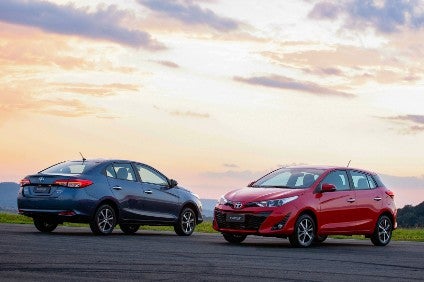
Despite the strong advance of SUVs, crossovers and ‘adventure’ variants of popular hatchbacks in Brazil, A- and B-segment hatchbacks still account for 60% of total passenger car registrations here, excluding single and double cab pick-ups. So automakers need to increase market share with additional types and sizes of vehicle.
Toyota has completed its product range by launching the Yaris e (Yaris ATIV in some markets) and pricing it midway between its entry level Etios and Corolla. Hatchback versions range from BRL59,590/US$16,000 to BRL77,590/$21,000, while saloons go from BRL63,990/$17,300 to BRL79,990/$21,600.
These prices are aligned to most recent competitor launches but the new Toyotas are not as competitive when equipment levels are compared.
The forecast is 55% of sales for the hatchback and 45% for the saloon totalling 6,000 units monthly in Brazil. Manual versions with the six-speed gearbox will account for just 5% of sales. The hatchback (different from the European version) is in showrooms first by the end of this month, followed by the saloon in July.
Compared to the locally built Volkswagen Polo, for example, the Yaris matches for roominess while the saloon is shadowed by the new [Polo saloon] Virtus with a wheelbase 10 cm longer. The Japanese newcomer counterattacks with a flat floor in the rear although it lacks the rear vents the competitor features.
The locally-made Yaris is larger than its European counterpart as it’s essentially the Thai model. Although the factory swears the architecture doesn’t comes from the Etios [which our PLDB database shows to be correct; Yaris ATIV shares the TMC NBC 2 platform with the European/Japanese Vitz/Yaris while the Etios is on the TMC-EFC platform – ed], wheelbase is exactly the same and tracks all but. The same size, 45-litre fuel tank reinforces the resemblance (the car would be better with a minimum of 50 litres).

US Tariffs are shifting - will you react or anticipate?
Don’t let policy changes catch you off guard. Stay proactive with real-time data and expert analysis.
By GlobalDataBoots range between 310 and 473 litres (hatch and saloon), volumes somewhat smaller than competitors’ on average (536 litres for the Honda City, for instance).
Both models have a seven-inch multimedia screen. Toyota continues to fit steering columns which ‘free-fall’ when you loosen the lock and there is only height, not reach, adjustment.
Interior materials are reasonable quality but the plastics are harsh to touch. The spare wheel cover made of some recycled material looks nasty. The jack is stored under the driver’s seat as in the Etios (and Prius).
Toyota has made minor changes to the two locally made Etios engines with are shared with the new Yaris models. They have gained 3bhp with the 1.3-litre now developing 101bhp (on ethanol) and the 1.5 110bhp. Performance is lower in the Yaris because the new model is some 150kg heavier.
But the difference is barely perceptible because the Yaris shares its ‘seven virtual speeds’ CVT automatic gearbox with the locally built Corollas.
The Brazilian Yaris has a good suspension set-up for local roads and is very quiet inside. The suspension absorbs bumps very well on uneven asphalt thanks partly to 15-inch wheels with deeper tyres.
Standard safety equipment includes ESC and just two airbags though the top XLS variant has seven.
Fog lamps, rarely used here in Brazil, are standard but daylight running lamps (DRL) are only a dealer-fit accessory.



